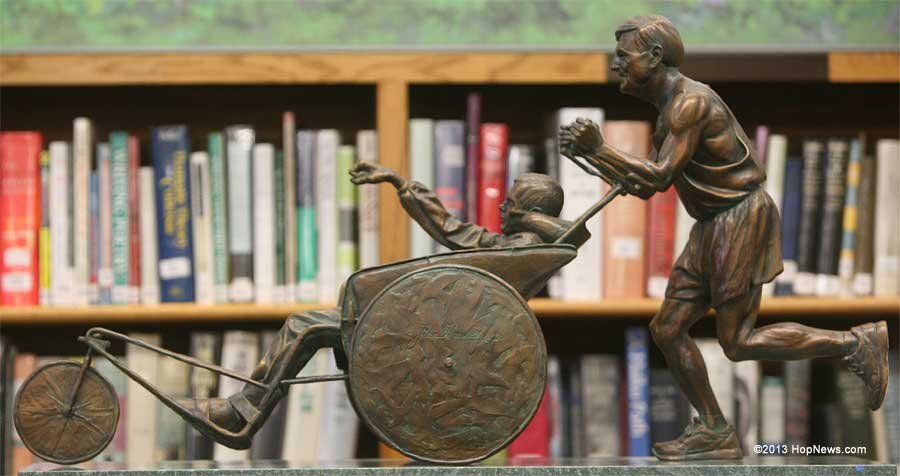“What’s really interesting about this chapter is that it speaks to a much broader audience of people who want to know, ‘Can I do something. Can I do this.’ And the message the Hoyts’ deliver is, ‘Yes you can.’”
Boston Globe
Posted Apr 8, 2013
HOPKINTON — For 30 years, Dick and Rick Hoyt have brought spectators along the 26.2-mile route of the Boston Marathon to tears.
But on Monday morning, it was the father-son team from Holland, Mass., who were overflowing with emotion.
In a 30-minute ceremony, involving Hopkinton students, a life-size bronze statue — commissioned by John Hancock — was unveiled on the lawn of the Center School, just yards from the starting line of the Marathon.
“It was just unbelievable,” said Dick Hoyt.
Over the past three decades, the image of 73-year-old Dick, pushing his son, Rick, 51, who is a quadriplegic and has cerebral palsy, has become synonymous with Patriots’ Day.
“It was just unbelievable,” Dick said of the ceremony. “I had tears in my eyes. To see after all these years of us running and competing. Who ever thought we would have a bronze statue made of us?
“It [doesn’t] get any better than that. To us this is the Stanley Cup, this is the World Series.”
Rick was equally emotional. As the statue was uncovered, he threw his arms high into the air and opened his mouth wide as if to release a shriek of exhilaration. It’s a reaction many are accustomed to witnessing when the Hoyts cross the finish line on Boylston Street.
The visual of Dick Hoyt pushing Rick defines self-sacrifice, heroism, and the bond between a father and son. The pair, who have spawned a charity, ‘Team Hoyt,’ which strives to inspire physically disabled people to become active community members, annually elicits memorable Marathon moments and loud cheers.
Team Hoyt embodies love, determination, and a selflessness that Dick and Rick display in every Marathon they enter. It goes well-beyond a website slogan of “Yes You Can!”
“It’s about inspiration,” said James Gallagher, an executive vice president at John Hancock. “You take that inspiration and you use it to help people understand that they shouldn’t define limits in their life. They should push beyond what other people tell them are the limit.”
In years past, local Marathon greats such Bill Rodgers and Johnny Kelley were bronzed because they were great runners who excelled on the grueling course. Rodgers won the race four times, while Kelley competed 61 straight years, including a record seven second-place finishes. The Hoyts’ narrative, however, isn’t one about streaks or victories.
“It’s another chapter in the great Boston Marathon story,” said Gallagher.
“What’s really interesting about this chapter is that it speaks to a much broader audience of people who want to know, ‘Can I do something. Can I do this.’ And the message the Hoyts’ deliver is, ‘Yes you can.’ ”
The Hoyts’s story is not lost on anyone, including Texas-based sculptor Mike Tabor, who knew the Hoyts’s background even before he started the project.
“Literally, this is going to be a story remembered forever,” he said. “To be asked to sculpt it, I was totally blown away.”
John Mosher, a Hopkinton selectman, was there on behalf of the town to accept the gift.
“Everybody talks about their inspiration and their message, but it’s also about the constant reminder of the endurance that it takes to achieve things,’’ he said. “That no matter how difficult things are, they can be achieved.”
The Hoyts, who will be competing in the Marathon on Monday for the 31st straight year, understand just how important their message has become even as each year presents a new, more daunting, challenge.
“I’ll be 73 in June and Rick is 51,” said Dick. “Our times are slowing down, but people don’t worry about that now because all people want to do is see us out there competing. It’s a lot of people out there competing just because we’ve been doing it for so many years.”





